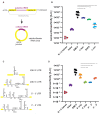A Split NanoLuc Reporter Quantitatively Measures Circular RNA IRES Translation
- PMID: 35205400
- PMCID: PMC8871761
- DOI: 10.3390/genes13020357
A Split NanoLuc Reporter Quantitatively Measures Circular RNA IRES Translation
Abstract
Internal ribosomal entry sites (IRESs) are RNA secondary structures that mediate translation independent from the m7G RNA cap. The dicistronic luciferase assay is the most frequently used method to measure IRES-mediated translation. While this assay is quantitative, it requires numerous controls and can be time-consuming. Circular RNAs generated by splinted ligation have been shown to also accurately report on IRES-mediated translation, however suffer from low yield and other challenges. More recently, cellular sequences were shown to facilitate RNA circle formation through backsplicing. Here, we used a previously published backsplicing circular RNA split GFP reporter to create a highly sensitive and quantitative split nanoluciferase (NanoLuc) reporter. We show that NanoLuc expression requires backsplicing and correct orientation of a bona fide IRES. In response to cell stress, IRES-directed NanoLuc expression remained stable or increased while a capped control reporter decreased in translation. In addition, we detected NanoLuc expression from putative cellular IRESs and the Zika virus 5' untranslated region that is proposed to harbor IRES function. These data together show that our IRES reporter construct can be used to verify, identify and quantify the ability of sequences to mediate IRES-translation within a circular RNA.
Keywords: RNA circles; internal ribosome entry site; reporter assay; split NanoLuc.
Conflict of interest statement
The authors declare that they have no conflict of interest with the contents of this article. The content is solely the responsibility of the authors.
Figures



References
Publication types
MeSH terms
Substances
Grants and funding
LinkOut - more resources
Full Text Sources
Medical
Research Materials
Miscellaneous

